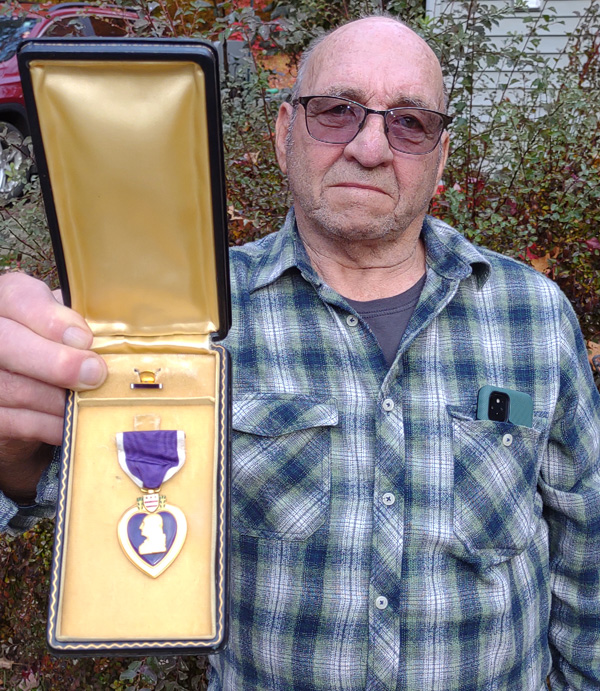By Kirk Rogers
According to the US Department of Defense, the week of May 5 to May 12, 1968, was the deadliest week for the US armed forces throughout the entire Vietnam War. Within that seven-day period, 562 service members were killed. Thousands more were wounded.
That same month of May was also the deadliest month of the conflict.
Likewise, 1968 was the deadliest year.
If a bullseye had been placed upon the American presence in Vietnam, it might well have hovered over that same week of that month of that year.
On May 5, 1968, at the beginning of that costliest of seven days, and at the onset of what would later become known as “mini Tet”, Garry Handrich, then twenty two years old and a farmer’s son from Fairview, Michigan, was less than a year in uniform, and but six months on Vietnamese soil.
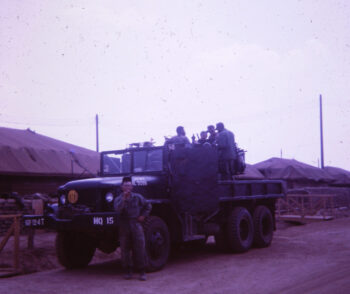
As a member of A Company’s 124th Transportation Battalion, Garry was a truck driver. On this day he was to drive a semi-truck as part of a convoy leaving Pleiku and deliver supplies to Kon Tum and then farther north to Dak To.
As had become usual of late, Garry would be pulling a trailer of artillery shells to be delivered to the big guns located atop a strategic inland plateau. It was a day-long round trip that he had made a number of times over the difficult roads that snaked through dense, hilly, and brutally humid forests.
Along the way they would pass the burnt out hulks of fire-blackened vehicles that previous convoys had been forced to abandon, now unworthy of even salvage. Each marked a solemn event where man and machine had engaged danger. It was not a trip to be approached casually and without caution.
But Garry had been lucky. Never before had one of his convoys been ambushed.
On this day that would change. Twice.
Home
All stories have a beginning. This one begins in Northern Michigan, some forty miles from Lake Huron, and at least a million miles from Vietnam.
Garry Handrich was a farm boy having been raised among the corn and hay fields between Mio and Fairview in Oscoda County. Most locals within the county had, by and large, been born and raised in similar fashion. If they themselves hadn’t been intimately exposed to farm life, it was likely that their parents or grandparents had.
Yet the larger world encroached.
In 1967, televisions weren’t yet in every household, but the strongest of AM signals from Detroit, Chicago and even Nashville reached, if only intermittently, the antennas of up north transistor radios.
The throaty voice of the tragically deceased Patsy Cline was still heartfully aired. And while the Grand Ole Opry may have reigned King, those upstart Monkees with their extended locks, flamboyant shirts, and even groovier pants were number one on the pop charts. The summer of love was in full swing. Heroin had invaded the cities. Detroit and Newark were close to ignition.
In 1967, still two years before the draft lottery, local draft boards served to conscript into the armed forces registered men of proper age and health. If you were drafted into military service you were less likely to go into the service branch you preferred and even less likely to attain an MOS (military operation specialty code) within the branch you desired.
Garry, hoping to be an Army driver, was among the volunteers.
Boot camp
He and two other friends from Fairview hopped on a blue painted school bus that routinely hauled service member hopefuls from small towns across Northern Michigan to military installations downstate. The bus stopped several times along the way to add a body or two. By the time the blue bus had arrived at the induction center at Fort Wayne in southwest Detroit, the bus contained some dozen future military personnel from towns that dotted the lower peninsula.
Physicals were taken. Forms were filled out. Information was both given and received. The blue bus returned Garry and his friends to Fairview, and then weeks later, on May 23, 1967, Garry was enlisted in the Army and taken to Fort Knox, Kentucky for eight weeks of basic training.
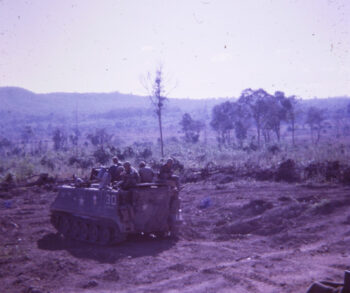
“It was more for physical conditioning and getting us in shape,” Gary said. “There was a lot of marching and hiking with heavy backpacks. We spent a lot of time on the rifle range.
“You learned to eat fast. A whole group of men would walk into the mess hall and in fifteen minutes the next group would arrive. When the next group came in you left the hall whether you were finished or not. We tried to finish.”
After boot camp and a quick week-long vacation back in Oscoda County, Garry entered another extended training stint at Fort Dix, New Jersey, for Truck Driving School.
Summer ended and autumn waned. Then, on November 4, 1967, Garry climbed aboard a commercial flight in Seattle expecting to be delivered to war. A brief moment of excitement came when he saw his first assignment was listed as being in Okinawa. The excitement was short-lived, however, when a few hours later a final flight lifted him out of Japan and deposited the young soldier at Cam Ranh Bay in the country of South Vietnam.
Vietnam
After traveling up the coast to Qui Nhon for orientation, several days later Garry was told to hop on a convoy truck that was headed inland toward what would become his primary base in Pleiku.
“I knew going in that Vietnam was a serious place. But on that first trip to Pleiku I heard machine gun fire. That’s when I knew it was real.”
The road that wound inland from Qui Nhon to Pleiku had received the name “Ambush Alley” for a reason.
Pleiku is deep in the heart of the country, as the crow flies some eighty miles inland from the Pacific and only thirty more from the Cambodian border. It was a major staging area for supplies that were received via convoy from Quin Nhon (such as the one Garry rode on to reach Pleiku) and then hauled along established supply lines elsewhere inland.
It was some weeks before Garry drove a semi hauling a trailer in a convoy. At first he drove gun trucks.
When the United States first entered into Vietnam and established a major presence, it didn’t take long for soldiers manning the convoys to figure out that they were facing an elusive and deadly enemy. Ambushes flared along the winding hilly roads with no notice, did their damage, and then quickly melted back into the forest. The convoys were sitting ducks and suffered great damage.
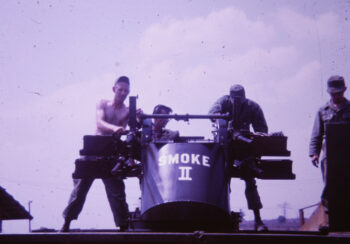
Inventive soldiers then began to construct what were called “gun trucks” to accompany the convoys and return deadly fire if they met resistance. These invaluable trucks began simply enough, where plates of steel, tires, sandbags and whatever else could be scrounged from bases, were attached to the back of an army vehicle. From within these makeshift boxes, gunners could fire on their enemies while remaining somewhat protected.
Later versions of the gun truck, those with which Garry became familiar, were much better fortified and carried serious firepower.
Garry’s Battalion, A Company of the 124th Transportation in Pleiku, had two such trucks, fondly named Smoke I and Smoke II. These gun trucks were surrounded by boxes of ¼” steel that housed four men; a machine gunner with an M-60, two loaders, and one man that could blast away with a mounted Quad 50.
One of Garry’s training sessions for the gun truck included him learning how to offset the tremendous force of the Quad 50s with first one, then two, and finally all barrels being fired at once.
“You could feel the truck jumping. If the gunner continued to fire all four guns at once it felt like it would turn the truck over.”
There were other issues with firing the guns too long.
“The barrels would get so hot that they would bend. The gunners were trained to fire in bursts, but we had to change a lot of barrels.”
Convoys were no longer easy targets.
“With a smaller gun they could hide behind trees. You can’t hide behind a tree with a Quad 50 firing. A Quad 50 could take down the smaller trees.”
Garry soon graduated from gun trucks to the semi-trucks that pulled trailers among the convoys. Convoys both arrived and left Pleiku on an almost daily basis. Incoming supplies reached Pleiku from Qui Nhon along the road that contained Ambush Alley. Deliveries included everything that a sizable military outpost might need for survival, such as food, clothing, medical supplies, building materials, fuel, ammunition, etc.
Many of these supplies stayed right in Pleiku to be used at the base and hospital. But, a great amount of it was simply staged in Pleiku to eventually be moved farther inland along roads perhaps not as notorious as Ambush Alley, but roads just as dangerous.
Ambush
Garry had hauled many types of cargo as a member of convoys that traveled back and forth along Ambush Alley from Pleiku to Qui Nhon, but most recently his main cargo had been trailers filled with artillery shells to be taken from Plieku, north through Kon Tum, and then farther north and west to Dak To where three 8” guns were stationed. Dak To was located less than 20 miles from where the borders of South Vietnam, Cambodia and Laos meet.
An uneventful trip from Pleiku through Kon Tum and on to Dak To would take about half the day. A convoy driver delivering supplies on that route could eat a quick lunch in the mess hall before making the return trip.
Meals in the mess at Dak To were not enjoyed in a relaxing environment.
“It happened every time I was there. I’d get a bite of food up to my mouth and one of those big guns would fire off a shot. I’d nearly bite my fork off.”
May 5, 1968 was to be another cautious and hopefully unexciting convoy from Pleiku to Dak To. Much of the road on the first leg of the journey was paved but rarely could the convoy trucks travel more than 45 miles per hour. It was difficult terrain and the roads took a beating.
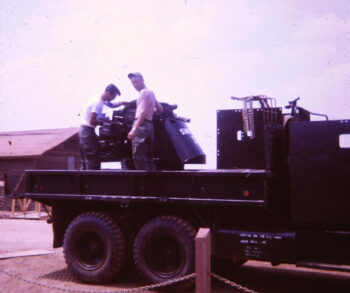
Army engineers worked on the roads relentlessly throughout the year, providing routine maintenance, smoothing them, sweeping for mines, and fixing any other damage that might result from any number of events common in a war zone. Road engineers also pushed tree lines back as far as one hundred yards to make staging an ambush much more difficult. One of their many important tasks was to construct long berms of piled sand and dirt along the roadways, two or three feet high, to provide cover for passing vehicles and men.
Engineers were highly vulnerable in the field and casualties were astonishingly high when confronted by enemy fire. Consequently, most engineer teams in the field were accompanied by Armored Personnel Carriers and gun trucks of their own.
Ambushes occurred quickly and without warning. In Vietnam, ambushes were primarily hit and run events where damage was meted out, and then the combatants disappeared almost as quickly as they had risen up. If ambushers fired too long, they could quickly be outgunned by responding gun trucks and called-in air support including Cobra helicopters equipped with guns capable of placing a bullet in every square foot of ground.
“They would only hit and run. They knew they couldn’t stick around very long.”
On the road between Pleiku and Kon Tum enemy fire erupted from the western tree line. This was the first ambush Garry had ever experienced, but he and the dozens of other convoy drivers did as they had been trained. Each truck veered off the road at an angle to the gunfire, first one to the right, the next to the left, and so on. The drivers also had to try and leave enough distance between their vehicles so that well placed ordnance could not inflict multiple casualties at once.
Once the drivers pulled off, they jumped out of their vehicles to take up positions behind the berms constructed by the engineering teams. A tanker truck hauling fuel veered off just a short distance behind Garry. The driver of the truck exited the vehicle and was running toward a berm when a rocket propelled grenade slammed into the side of the tanker and it blew into flames with such intensity that the driver, though not seriously injured, was blown off his feet.
After the ambush ended the convoy regrouped, with the inoperable trucks left behind and the drivers of those trucks, now with no vehicles of their own, doubling up in trucks that could resume the trip. The driver of the destroyed tanker ended up in the same cab with Garry, and on they went.
A few miles down the road, not yet to Kon Tum, the convoy was again ambushed.
As before, the trucks angled off the road. Garry quickly stopped the truck and had just started opening his door when he felt a burning in his left side.
“It really didn’t hurt that bad. It felt like a bee sting. I yelled out ‘I’m hit! I’m hit!’”
“Right away I knew my leg wasn’t working right. I pulled the door shut but my leg was numb.”
Garry half pushed and was half dragged backwards by the second occupant, out of the passenger door, shoulders first, and away from direct gunfire.
Then on the ground with one leg useless and unfeeling, he was further pulled behind a berm to protect him from continuing gunfire. He still lay a quarter mile from any area where a medivac helicopter might safely land.
Garry ripped off his shirt and did his best to stem the bleeding by pressing it to his left side just beneath the rib cage. It was surprising and scary. He knew he had been hit, but it wasn’t until he was on the ground and trying to administer his own first aid that he discovered the extent of his wounds.
Then he waited, gunfire overhead, bleeding, and no medics on the ground.
After a few minutes the firing stopped and Garry, weaker by the minute, was lifted back into the cab of his truck to rest more comfortably. There he passed out for the first time.
Finally, an APC from a nearby engineering team arrived. Garry was roused and placed inside the vehicle and taken to where the medivac chopper had landed. Unable to walk, Garry was carried into the chopper and deposited on the flat, hard, and metal floor.
“I ended up laying between the front seats of the chopper. There were maybe ten other injured men. The guys try to be careful but they know the chopper can’t stay on the ground. I was more or less dumped there.”
Shortly thereafter, aloft and headed to the Army hospital some fifteen minutes away, for the second time, Garry lost consciousness.
He awoke again when the chopper landed at the hospital in Pleiku. There his memory becomes somewhat blurred.
“I was on a stretcher and being wheeled inside. I was surrounded by several people working on me. They asked me if I was getting sleepy. I woke up a couple of days later.”
“I spoke with the doctor after I was awake. He told me he left three bullets on the nightstand. I never saw them. They were gone by the time I woke up. I have no idea what happened to them.”
Recovery
After surgery and a few days in Pleiku, Garry spent a week recovering in Cam Ranh Bay. Shortly thereafter he was on a C-130 to the States, refueling once in Anchorage (where he regrettably had to stay aboard the plane) and finally landing in Minot, North Dakota where he continued to recover. Coincidentally, in Minot, Garry was able to recover in the same hospital where another Fairview enlistee was stationed. Bill Knepp, of the Air Force, worked in that very hospital. They didn’t realize how close their paths had come to crossing until years later.
It wasn’t until he had reached Minot that he was finally able to talk to his father by telephone back in Oscoda County. The family had been informed of Garry’s wounds but were aware of little else.
“Dad told me that he was afraid he’d never see me again.”
After leaving Vietnam and Anchorage and Minot, having almost fully recovered but for wearing a leg brace that helped him with mobility for several months, Garry served out the rest of his three years in the army being finally discharged on May 22, 1970. He had served 1,096 days, that being three years on the nose, and one of them being a leap year. The remainder of those three years were spent in many locations, primarily along the east coast, testing equipment for the army.
Garry still has three distinct scars on his left abdomen, marking an almost perfect equilateral triangle. The wounds, long healed, became painless much sooner than the memories of Vietnam.


